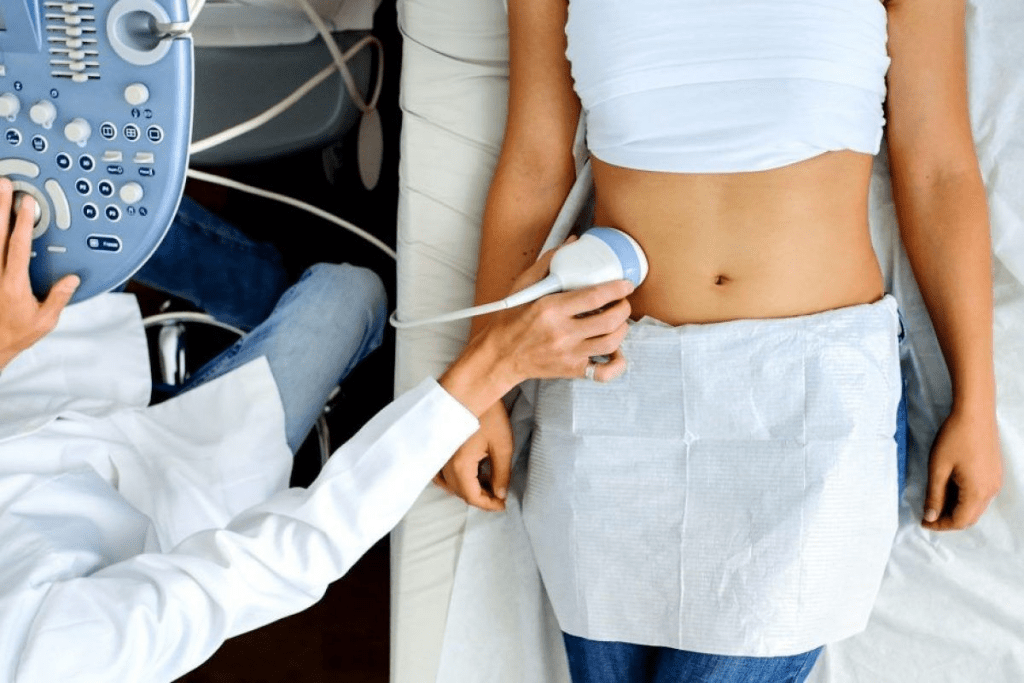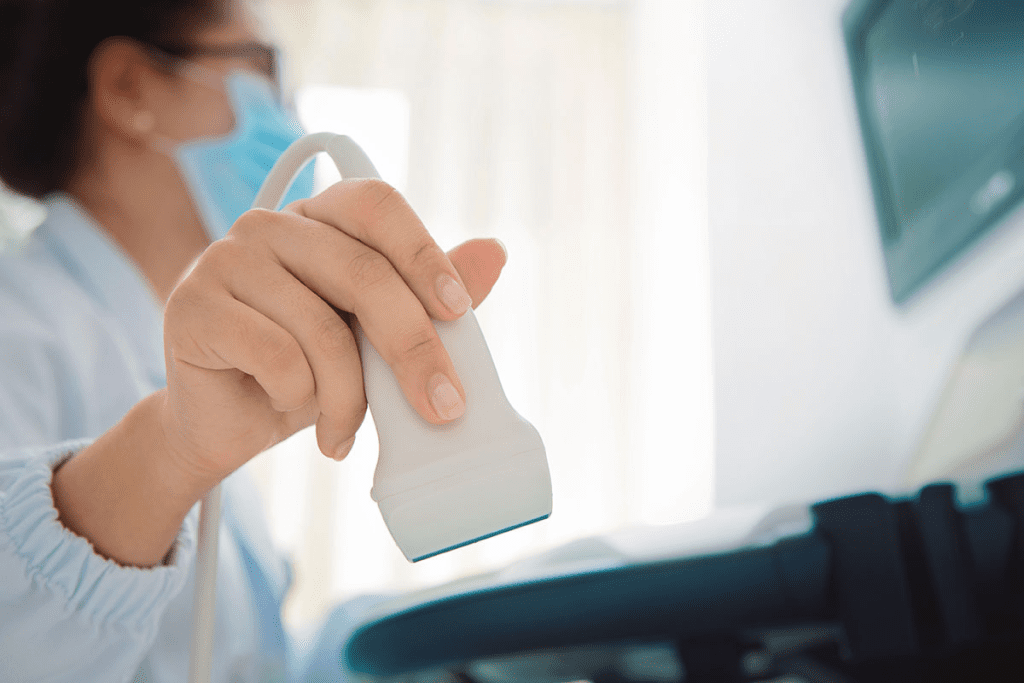Last Updated on November 25, 2025 by
When you’re getting ready for a bladder ultrasound, what you wear matters. It affects how comfortable you are and how well the test works.
It’s best to wear comfortable, loose-fitting clothes that you can take off or adjust easily. This makes it simpler for the ultrasound tech to get to the right spot.

Opt for a two-piece outfit, like a shirt and pants or a dress that can be lifted. Stay away from tight clothes that might be uncomfortable during the test.
It’s important for patients to know about the bladder ultrasound procedure before they go through it. A bladder ultrasound uses sound waves to create images of the bladder and nearby organs. This test is non-invasive.

A bladder ultrasound, or bladder sonogram, shows pictures of your bladder. It looks at the bladder wall and pouches. It helps find problems like bladder stones, cysts, and tumors.
This tool is key for spotting bladder and pelvic issues.
Bladder ultrasounds help diagnose and track many bladder and pelvic problems. Here are some reasons for getting a bladder ultrasound:
There are several pelvic ultrasounds, like transabdominal and transvaginal. Transabdominal ultrasounds are done from the outside. Transvaginal ultrasounds use a probe in the vagina for better views.
The choice of ultrasound depends on the condition and the patient’s health.
When you’re getting ready for a bladder ultrasound, what you wear matters a lot. It affects how comfortable you are and how well the test goes. We know that feeling at ease and being practical are important during medical checks.
It’s best to wear loose-fitting, comfortable clothing for your ultrasound. This kind of clothing lets you move freely and change easily. It makes the test easier for you and the person doing the ultrasound.
Two-piece outfits are great for bladder ultrasounds. They let you access your belly area easily without having to take off all your clothes. This makes the whole thing less awkward and more comfy.

At times, you might get a hospital gown to wear. This is if the ultrasound tech needs to get to a certain spot on your body. Remember, wearing a hospital gown is common in many medical tests. It helps the test go smoothly and quickly.
Choosing the right clothes and being ready to put on a hospital gown can make your ultrasound less uncomfortable. It also makes sure the test works well.
To get clear images during your bladder ultrasound, take off certain jewelry and accessories. These items can block the ultrasound waves. This might make the images unclear or misleading.
It’s key to remove jewelry in the scan area, like belly button piercings or metal waistbands. These can create artifacts or shadows on the ultrasound. This makes it hard for doctors to read the results right.
Other accessories can also affect the ultrasound. For example, tight clothes or clothes with metal parts can sometimes get in the way. It’s best to wear loose, comfy clothes to your appointment.
After removing your jewelry and accessories, it’s important to store them safely. Many healthcare places have secure spots for your items during procedures. If not, ask a friend or family member to keep them.
By following these guidelines, you can help ensure that your bladder ultrasound is conducted smoothly and that the images obtained are of the highest quality.
To see pelvic organs clearly, a full bladder is key during an ultrasound. A full bladder makes images better, helping doctors make accurate diagnoses.
A full bladder is important for moving intestines out of the way. This makes it easier for ultrasound waves to get through. It helps the ultrasound tech get clear pictures of the bladder, uterus, and prostate.
Key benefits of a full bladder during an ultrasound include:
To get a full bladder, drink 32 ounces (1 liter) of water 30 to 45 minutes before your ultrasound. It’s important to drink at the right time so your bladder is full but not too full.
Drinking water at the right time is important. We suggest drinking the water and then waiting until after the ultrasound to go to the bathroom. This makes sure your bladder is full and ready for the best images.
Here’s a simple guideline to follow:
If you can’t hold your bladder, tell the ultrasound technologist. They can help you do the exam comfortably. They might need to change the way they do the exam or offer other help.
When getting ready for a bladder ultrasound, think about your diet. This helps make the procedure go smoothly. You can usually eat and drink as you normally do on the day of your ultrasound. But, there might be some special things to remember.
Most of the time, you can eat before a bladder ultrasound. But, it’s important to listen to any special rules from your doctor or the ultrasound place. Some ultrasounds might ask you to skip certain foods or drinks that could mess with the pictures.
Some foods and drinks can mess with the ultrasound pictures. For example:
Staying away from these foods can help your ultrasound go well and get the best results.
While most bladder ultrasounds follow the same diet rules, some special types might need different food plans. For example:
It’s key to follow the diet advice from your doctor or the ultrasound team. They’ll tell you what to eat and drink to get the best results from your procedure.
By paying attention to your diet before a bladder ultrasound and following the right guidelines, you can make sure your experience is successful and stress-free.
To get accurate results, following a specific preparation timeline for your bladder ultrasound is key. This prep is vital for clear images of your pelvic organs.
Before your ultrasound, there are a few steps to take. You don’t need to follow any special diet, but avoid foods that cause gas. Wear loose, comfortable clothing for easy access to your lower abdomen.
Drinking lots of water is a big part of getting ready for your ultrasound. You’ll need to drink 32 ounces or 1 liter of water 30-60 minutes before your visit. This fills your bladder, giving a clearer view of your pelvic organs. Make sure to drink the water as instructed.
Arrive at the ultrasound clinic 15 minutes before your appointment to do paperwork and register. This gets you ready for your procedure on time. You can also ask any last-minute questions and get settled before the ultrasound.
Children and elderly patients have special needs for bladder ultrasound prep. Kids might need help drinking enough water, and seniors might need help with hydration or getting around. We tailor our care to meet your unique needs for your comfort and the success of your ultrasound.
By following this preparation timeline and considering your special needs, your bladder ultrasound will go smoothly. If you have questions or concerns, talk to your healthcare provider for help.
Getting ready is essential for a good bladder ultrasound exam. By following the tips in this article, you can make sure your exam goes smoothly. This way, your results will be accurate and reliable.
At LIV Hospital, we know how important being prepared is. Our team works hard to give you top-notch care. We support you every step of the way, helping you get the best from your bladder ultrasound.
Wearing comfy clothes, taking off jewelry, and having a full bladder are key steps. These actions help make sure your ultrasound is a success. Our focus on your care and comfort shows in every detail of your treatment.
Wear loose, comfy clothes that can be easily changed. A two-piece outfit is good. Stay away from tight clothes that might be uncomfortable during the test.
You can eat and drink as you normally do before the test. But we might give you special food rules. We’ll tell you what to eat and drink before your visit.
A full bladder makes it easier to see the pelvic organs. This helps the ultrasound tech get clear images.
Drink 32 ounces of water about 30 minutes before. This will help you have a full bladder for the exam.
There are different types of ultrasounds for the bladder and pelvic area. These include transabdominal and transvaginal ultrasounds.
Yes, take off any jewelry or accessories. This includes jewelry from your waist area. It helps with the imaging process.
The time for a bladder ultrasound can vary. We’ll give you a detailed plan to make sure your exam goes smoothly and quickly.
Yes, we have special plans for kids and older adults. We want to make sure they’re comfortable and safe during the exam.
If you can’t hold your bladder, tell our staff. We’ll help you figure out what to do next.
Subscribe to our e-newsletter to stay informed about the latest innovations in the world of health and exclusive offers!